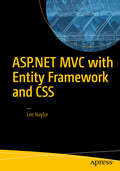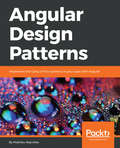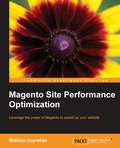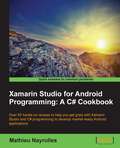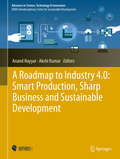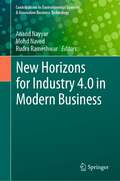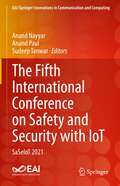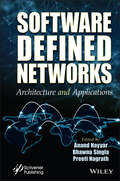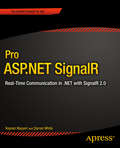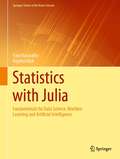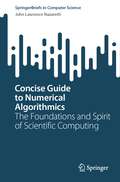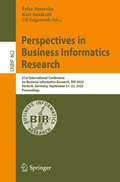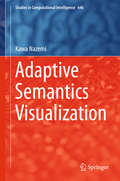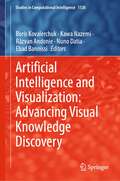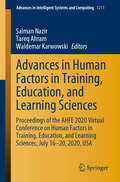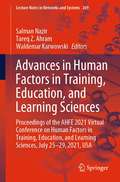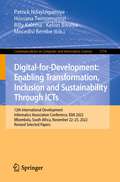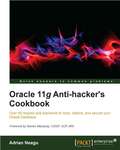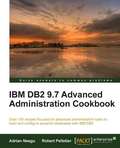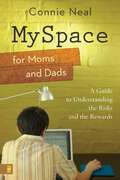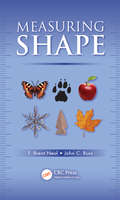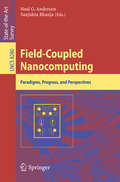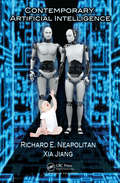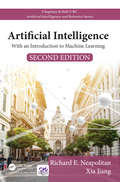- Table View
- List View
ASP.NET MVC with Entity Framework and CSS
by Lee NaylorGet up and running quickly with Microsoft ASP. NET MVC and Entity Framework as you build and deploy complex websites. By using a fully working example retail website you will learn solutions to real-world issues that developers frequently encounter. Whether you are a novice developer or an experienced . NET developer wishing to learn more about MVC and Entity Framework, author Lee Naylor will teach you how to develop a detailed database-driven example website using Microsoft ASP. NET and Entity Framework Code First with fully explained code examples. What You Will Learn: * Get up and running quickly with ASP. NET MVC and Entity Framework to build a complex website to display and manage several related entities * Integrate identity code into a project * Understand advanced topics, including asynchronous database access and managing data conflicts * Work with Microsoft Azure, including remote debugging and database access * Develop your CSS skills, including animations and media queries for use with tablet or mobile/cell phone devices Who This Book Is For: Novice developers new to the subject through to more experienced ASP. NET web forms developers looking to migrate from web forms to MVC and Entity Framework. The book assumes some programming knowledge such as object-oriented programming concepts and a basic knowledge of C#.
Angular Design Patterns: Implement the Gang of Four patterns in your apps with Angular
by Mathieu NayrollesMake the most of Angular by leveraging design patterns and best practices to build stable and high performing appsKey FeaturesGet to grips with the benefits and applicability of using different design patterns in Angular with the help of real-world examplesIdentify and prevent common problems, programming errors, and anti-patternsPacked with easy-to-follow examples that can be used to create reusable code and extensible designsBook DescriptionThis book is an insightful journey through the most valuable design patterns, and it will provide clear guidance on how to use them effectively in Angular. You will explore some of the best ways to work with Angular and how to use it to meet the stability and performance required in today's web development world. You’ll get to know some Angular best practices to improve your productivity and the code base of your application.We will take you on a journey through Angular designs for the real world, using a combination of case studies, design patterns to follow, and anti-patterns to avoid.By the end of the book, you will understand the various features of Angular, and will be able to apply well-known, industry-proven design patterns in your work.What you will learnUnderstand Angular design patterns and anti-patternsImplement the most useful GoF patterns for Angular Explore some of the most famous navigational patterns for Angular Get to know and implement stability patternsExplore and implement operations patternsExplore the official best practices for Angular Monitor and improve the performance of Angular applicationsWho this book is forIf you want to increase your understanding of Angular and apply it to real-life application development, then this book is for you.
Magento Site Performance Optimization
by Mathieu NayrollesMagento Site Performance Optimization follows a handson, easytofollow approach, which focuses on the optimization of Magento's performance. Each chapter has a very logical flow, which makes the book readerfriendly. This book is written for Magento administrators who wish to optimize their store to increase performance, without spending thousands of dollars a year for the enterprise edition of Magento. It is noteworthy that Magento, as a project, comes with a gigantic code base and tools; however, the reader needs to be up for the challenge, ready to produce their own code to make the most of its code base.
Xamarin Studio for Android Programming: A C# Cookbook
by Mathieu NayrollesOver 50 hands-on recipes to help you get grips with Xamarin Studio and C# programming to develop market-ready Android applications About This Book * Create Android applications with C# and Xamarin * Reuse your Android application to develop iOS and Windows Phone applications * Leverage the easy-to-succeed recipes to exploit the latest Android releases and develop new applications Who This Book Is For If you have already developed an Android applications with Java and you now intend to use C# and Xamarin Studio's capabilities, or if you have never taken the dive into mobiles, then this book is for you. It would be helpful to have some C# experience so you follow the recipes in this book, though knowledge of Android is not required. What You Will Learn * Build a GUI for your Android applications * Explore Android activities and understand configuration changes * Manage multiscreens, icons, and multimedia in your applications * Start and bind Android services and create notifications * Create beautiful applications using the camera and animations * Effectively couple your phone's hardware with applications * Integrate advertisements and select the right advertisement providers for your applications In Detail Multiplatform applications have taken the development world by storm. This has revolutionized the selection of the right tools for the efficient development and deployment of applications. Xamarin studio is emerging as the preferred choice among .NET/C# developers. It enables them to design cross-platform applications using their favorite language and IDE. Xamarin studio is supported by the Mac OS and Windows platforms, and you can develop your own applications for iOS, Windows, or Android with its help. This book takes you through all the stages of application development, right from getting started with Xamarin and developing a GUI to putting up your application on the store. The recipes will help you in acquiring sufficient knowledge to go about creating applications. Starting with introducing Xamarin studio, its underlying technologies, and the Android ecosystem, the book goes on to cover the graphical aspects of creating Android applications. Moving on, you will learn more about data management with Android services. This is followed by techniques on how to interact with the Android OS and the phone's hardware, before finally concluding with mobile advertisements and Google Play. By the end of this book, you will have discovered all the specialties related to developing Android application with Xamarin Studio. Style and approach This book is organized around hands-on and practical recipes that focus on the development of Android applications using C# and Xamarin. Each recipe is easy to follow to help you progress efficiently through the book.
A Roadmap to Industry 4.0: Smart Production, Sharp Business and Sustainable Development (Advances in Science, Technology & Innovation)
by Anand Nayyar Akshi KumarBusiness innovation and industrial intelligence are paving the way for a future in which smart factories, intelligent machines, networked processes and Big Data are combined to foster industrial growth. The maturity and growth of instrumentation, monitoring and automation as key technology drivers support Industry 4.0 as a viable, competent and actionable business model. This book offers a primer, helping readers understand this paradigm shift from industry 1.0 to industry 4.0. The focus is on grasping the necessary pre-conditions, development & technological aspects that conceptually describe this transformation, along with the practices, models and real-time experience needed to achieve sustainable smart manufacturing technologies. The primary goal is to address significant questions of what, how and why in this context, such as:What is Industry 4.0?What is the current status of its implementation?What are the pillars of Industry 4.0?How can Industry 4.0 be effectively implemented?How are firms exploiting the Internet of Things (IoT), Big Data and other emerging technologies to improve their production and services?How can the implementation of Industry 4.0 be accelerated?How is Industry 4.0 changing the workplace landscape?Why is this melding of the virtual and physical world needed for smart production engineering environments?Why is smart production a game-changing new form of product design and manufacturing?
New Horizons for Industry 4.0 in Modern Business (Contributions to Environmental Sciences & Innovative Business Technology)
by Anand Nayyar Mohd Naved Rudra RameshwarThis book discovers what it will take to reindustrialize the previous industrial powerhouses in order to offset the advantages of cheap labor suppliers dominating the industrial sector by exploring the current situation of the production, processing, and manufacturing industries. The Internet of Things (IoT), Big Data, Cyber-Physical Systems (CPS), and Cloud Computing, Cyber Security, Cobotics, Automation, AI, 3D Printing and Additive Manufacturing, SDN, Blockchain technologies are outlined in this unique and comprehensive book, which has true potential for professionals, researchers, policymakers, and book users. New Horizons for Industry 4.0 in Modern Business encompass trends in business and technology globally that may completely alter how manufacturing and production are conducted. What you will discover: Learn about the Industrial Internet of Things and the Industrial Internet. Learn about the technologies that must develop to support Industry 4.0 and what is being done right now to make that happen. In this book, the topic of Industry 4.0 is covered in detail, and it even moves on to concepts of Digital Twins to boost output and create Industrial Internet of Things. With the development of new digital industrial technology, or "Industry 4.0," it is now feasible to collect and analyze data from many machines, resulting in processes that are quicker, more adaptable, and more efficient, producing things of higher quality while spending less money. The manufacturing revolution will boost productivity, alter economics, promote industrial development, and alter workforce demographics, ultimately altering the competitiveness of businesses and areas. Although advanced digital technology is being employed in manufacturing, Industry 4.0 will completely change how things are done. Greater production efficiencies will result, and conventional connections between suppliers, manufacturers, and consumers—as well as between people and machines—will shift. Industry 4.0 is changing the business process. This disruptive technology is radically changing the way businesses/manufacturing is conducted. It will give machines that little bit of intuition with the help of robotics, 3D printing, artificial intelligence, augmented reality, and virtual reality—that will help them do mindless and repetitive jobs without human intervention, allowing humans to focus more on their core competencies.
The Fifth International Conference on Safety and Security with IoT: SaSeIoT 2021 (EAI/Springer Innovations in Communication and Computing)
by Anand Nayyar Anand Paul Sudeep TanwarThis book presents the Fifth International Conference on Safety and Security with IoT (SaSeIoT 2021), which took place online. The conference aims to explore not only IoT and its related critical applications but also IoT towards Security and Safety. The conference solicits original and inspiring research contributions from experts, researchers, designers, and practitioners in academia, industry and related fields and provides a common platform to share knowledge, experience and best practices in various domains of IoT.
Software Defined Networks: Architecture and Applications
by Anand Nayyar Bhawna Singla Preeti NagrathSOFTWARE DEFINED NETWORKS Software defined networking suggests an alternative worldview, one that comes with a new software stack to which this book is organized, with the goal of presenting a top-to-bottom tour of SDN without leaving any significant gaps that the reader might suspect can only be filled with magic or proprietary code. Software defined networking (SDN) is an architecture designed to make a network more flexible and easier to manage. SDN has been widely adopted across data centers, WANs, and access networks and serves as a foundational element of a comprehensive intent-based networking (IBN) architecture. Although SDN has so far been limited to automated provisioning and configuration, IBN now adds “translation” and “assurance” so that the complete network cycle can be automated, continuously aligning the network to business needs. In 14 chapters, this book provides a comprehensive understanding of an SDN-based network as a scalable distributed system running on commodity hardware. The reader will have a one-stop reference looking into the applications, architectures, functionalities, virtualization, security, and privacy challenges connected to SDN. Audience Researchers in software, IT, and electronic engineering as well as industry engineers and technologists working in areas such as network virtualization, Python network programming, CISCO ACI, software defined network, and cloud computing.
Pro ASP.NET SignalR
by Keyvan Nayyeri Darren WhiteASP. NET SignalR is the new solution to real-time communication between servers and clients in . NET. Use it to push new data to a web page or mobile device as soon as it becomes available, whether it's a notification, live chat, up-to-the-minute financial data, or a range of other exciting applications. Innovations like Google live search and live Facebook and Twitter updates are pushing users' expectations of the real-time web. With Pro ASP. NET SignalR, you can join this revolution and learn skills that will be valuable for years to come. Pro ASP. NET SignalR starts with an introduction to the real-time web. Learn about the technologies underlying the SignalR library, such as WebSockets and long-polling, and how SignalR elegantly flips between them depending on the capabilities of the client. Next, meet the concepts of hubs and persistent connections and how to use them to build the components of an ASP. NET SignalR application. Find out how to extend, test, debug, configure, scale, and host your applications, and how to target a range of clients, including Windows and iOS. The book rounds off with two case studies--a stock market price updater, and a collaborative drawing application--so you can get to grips with SignalR in a realistic scenario, using a broad range of the concepts covered in earlier chapters. As real-time updates to web and mobile apps become the norm, Pro ASP. NET SignalR will be your in-depth, one-stop companion to this new and exciting technology.
Statistics with Julia: Fundamentals for Data Science, Machine Learning and Artificial Intelligence (Springer Series in the Data Sciences)
by Yoni Nazarathy Hayden KlokThis monograph uses the Julia language to guide the reader through an exploration of the fundamental concepts of probability and statistics, all with a view of mastering machine learning, data science, and artificial intelligence. The text does not require any prior statistical knowledge and only assumes a basic understanding of programming and mathematical notation. It is accessible to practitioners and researchers in data science, machine learning, bio-statistics, finance, or engineering who may wish to solidify their knowledge of probability and statistics. The book progresses through ten independent chapters starting with an introduction of Julia, and moving through basic probability, distributions, statistical inference, regression analysis, machine learning methods, and the use of Monte Carlo simulation for dynamic stochastic models. Ultimately this text introduces the Julia programming language as a computational tool, uniquely addressing end-users rather than developers. It makes heavy use of over 200 code examples to illustrate dozens of key statistical concepts. The Julia code, written in a simple format with parameters that can be easily modified, is also available for download from the book’s associated GitHub repository online.See what co-creators of the Julia language are saying about the book:Professor Alan Edelman, MIT: With “Statistics with Julia”, Yoni and Hayden have written an easy to read, well organized, modern introduction to statistics. The code may be looked at, and understood on the static pages of a book, or even better, when running live on a computer. Everything you need is here in one nicely written self-contained reference. Dr. Viral Shah, CEO of Julia Computing: Yoni and Hayden provide a modern way to learn statistics with the Julia programming language. This book has been perfected through iteration over several semesters in the classroom. It prepares the reader with two complementary skills - statistical reasoning with hands on experience and working with large datasets through training in Julia.
Concise Guide to Numerical Algorithmics: The Foundations and Spirit of Scientific Computing (SpringerBriefs in Computer Science)
by John Lawrence NazarethNumerical Algorithmic Science and Engineering (NAS&E), or more compactly, Numerical Algorithmics, is the theoretical and empirical study and the practical implementation and application of algorithms for solving finite-dimensional problems of a numeric nature. The variables of such problems are either discrete-valued, or continuous over the reals, or, and as is often the case, a combination of the two, and they may or may not have an underlying network/graph structure. This re-emerging discipline of numerical algorithmics within computer science is the counterpart of the now well-established discipline of numerical analysis within mathematics, where the latter’s emphasis is on infinite-dimensional, continuous numerical problems and their finite-dimensional, continuous approximates. A discussion of the underlying rationale for numerical algorithmics, its foundational models of computation, its organizational details, and its role, in conjunction with numerical analysis, in support of the modern modus operandi of scientific computing, or computational science & engineering, is the primary focus of this short monograph. It comprises six chapters, each with its own bibliography. Chapters 2, 3 and 6 present the book’s primary content. Chapters 1, 4, and 5 are briefer, and they provide contextual material for the three primary chapters and smooth the transition between them. Mathematical formalism has been kept to a minimum, and, whenever possible, visual and verbal forms of presentation are employed and the discussion enlivened through the use of motivating quotations and illustrative examples. The reader is expected to have a working knowledge of the basics of computer science, an exposure to basic linear algebra and calculus (and perhaps some real analysis), and an understanding of elementary mathematical concepts such as convexity of sets and functions, networks and graphs, and so on. Although this book is not suitable for use as the principal textbook for a course on numerical algorithmics (NAS&E), it will be of value as a supplementary reference for a variety of courses. It can also serve as the primary text for a research seminar. And it can be recommended for self-study of the foundations and organization of NAS&E to graduate and advanced undergraduate students with sufficient mathematical maturity and a background in computing. When departments of computer science were first created within universities worldwide during the middle of the twentieth century, numerical analysis was an important part of the curriculum. Its role within the discipline of computer science has greatly diminished over time, if not vanished altogether, and specialists in that area are now to be found mainly within other fields, in particular, mathematics and the physical sciences. A central concern of this monograph is the regrettable, downward trajectory of numerical analysis within computer science and how it can be arrested and suitably reconstituted. Resorting to a biblical metaphor, numerical algorithmics (NAS&E) as envisioned herein is neither old wine in new bottles, nor new wine in old bottles, but rather this re-emerging discipline is a decantation of an age-old vintage that can hopefully find its proper place within the larger arena of computer science, and at what appears now to be an opportune time.
Raspberry Pi Media Center
by Sam NazarkoConstructed as a set of simple-to-follow, step-by-step instructions, this book will take you through numerous aspects of creating a fully functional media center with your Raspberry Pi. It is an easy-to-follow yet comprehensive guide to setting a complete media center experience using the revolutionary ARM GNU/Linux board.This book does not require any prior knowledge of the Raspberry Pi, but it does assume you are computer literate and comfortable with Mac OS X, Linux, or Windows and concepts such as installing software.
Perspectives in Business Informatics Research: 21st International Conference on Business Informatics Research, BIR 2022, Rostock, Germany, September 21–23, 2022, Proceedings (Lecture Notes in Business Information Processing #462)
by Ērika Nazaruka Kurt Sandkuhl Ulf SeigerrothThis book constitutes the proceedings of the 21st International Conference on Perspectives in Business Informatics Research, BIR 2022, which took place in Rostock, Germany, in September 2022. The central theme of BIR 2022 was “Business Informatics for Sustainable Innovation”. Achieving sustainability requires a multi-perspective approach taking organizational, economic, and technical aspects into account. In a world of cloud computing, social networks and big data, additional challenges for business informatics and the design of information systems architectures are introduced. To deal with these challenges, a close cooperation of researchers from different disciplines such as information systems, business informatics, and computer science is required.The 14 papers presented in this volume were carefully reviewed and selected from 41 submissions. They were organized in topical sections as follows: Information system development; modeling methods and assistance; applications and technologies; and digital business.
Adaptive Semantics Visualization (Studies in Computational Intelligence #646)
by Kawa NazemiThis bookintroduces a novel approach for intelligent visualizations that adapts thedifferent visual variables and data processing to human's behavior and giventasks. Thereby a number of new algorithms and methods are introduced to satisfythe human need of information and knowledge and enable a usable and attractiveway of information acquisition. Each method and algorithm is illustrated in areplicable way to enable the reproduction of the entire "SemaVis" system orparts of it. The introduced evaluation is scientifically well-designed andperformed with more than enough participants to validate the benefits of themethods. Beside the introduced new approaches and algorithms, readers may finda sophisticated literature review in Information Visualization and VisualAnalytics, Semantics and information extraction, and intelligent and adaptivesystems. This book is based on an awarded and distinguished doctoral thesis incomputer science.
Artificial Intelligence and Visualization: Advancing Visual Knowledge Discovery (Studies in Computational Intelligence #1126)
by Kawa Nazemi Boris Kovalerchuk Răzvan Andonie Nuno Datia Ebad BannissiThis book continues a series of Springer publications devoted to the emerging field of Integrated Artificial Intelligence and Machine Learning with Visual Knowledge Discovery and Visual Analytics that combine advances in both fields. Artificial Intelligence and Machine Learning face long-standing challenges of explainability and interpretability that underpin trust. Such attributes are fundamental to both decision-making and knowledge discovery. Models are approximations and, at best, interpretations of reality that are transposed to algorithmic form. A visual explanation paradigm is critically important to address such challenges, as current studies demonstrate in salience analysis in deep learning for images and texts. Visualization means are generally effective for discovering and explaining high-dimensional patterns in all high-dimensional data, while preserving data properties and relations in visualizations is challenging. Recent developments, such as in General Line Coordinates, open new opportunities to address such challenges.This book contains extended papers presented in 2021 and 2022 at the International Conference on Information Visualization (IV) on AI and Visual Analytics, with 18 chapters from international collaborators. The book builds on the previous volume, published in 2022 in the Studies in Computational Intelligence. The current book focuses on the following themes: knowledge discovery with lossless visualizations, AI/ML through visual knowledge discovery with visual analytics case studies application, and visual knowledge discovery in text mining and natural language processing. The intended audience for this collection includes but is not limited to developers of emerging AI/machine learning and visualization applications, scientists, practitioners, and research students. It has multiple examples of the current integration of AI/machine learning and visualization for visual knowledge discovery, visual analytics, and text and natural language processing. The book provides case examples for future directions in this domain. New researchers find inspiration to join the profession of the field of AI/machine learning through a visualization lens.
Advances in Human Factors in Training, Education, and Learning Sciences: Proceedings of the AHFE 2020 Virtual Conference on Human Factors in Training, Education, and Learning Sciences, July 16-20, 2020, USA (Advances in Intelligent Systems and Computing #1211)
by Salman Nazir Tareq Ahram Waldemar KarwowskiThis book addresses the importance of human factors in optimizing the learning and training process. It reports on the latest research and best practices, and discusses key principles of behavioral and cognitive science, which are extremely relevant to the design of instructional content and new technologies to support mobile and multimedia learning, virtual training and web-based learning, among others, as well as performance measurements, social and adaptive learning and many other types of educational technology, with a special emphasis on those important in the corporate, higher education, healthcare and military training contexts. Gathering contributions to the AHFE 2020 Virtual Conference on Human Factors in Training, Education, and Learning Sciences, held on July 16–20, 2020, the book offers a timely perspective on the role of human factors in education. It highlights important new approaches and ideas, and fosters new discussions on how to optimally design learning experiences.
Advances in Human Factors in Training, Education, and Learning Sciences: Proceedings of the AHFE 2021 Virtual Conference on Human Factors in Training, Education, and Learning Sciences, July 25-29, 2021, USA (Lecture Notes in Networks and Systems #269)
by Salman Nazir Tareq Z. Ahram Waldemar KarwowskiThis book addresses the importance of human factors in optimizing the learning and training process. It reports on the latest research and best practices relating to the application of behavioral and cognitive science, and new technologies in the design of instructional and training content. It proposes innovative strategies for improving the learning and training experience and outcomes in different contexts, including lower and higher education, and different industry sectors. A special emphasis is given to digital and distance learning, gamification, and virtual training. Gathering contributions to the AHFE 2021 Conference on Human Factors in Training, Education, and Learning Sciences, held virtually on July 25-29, 2021, from USA, this book offers extensive information and a thought-provoking guide for both researchers and practitioners in the field of education and training.
Digital-for-Development: 12th International Development Informatics Association Conference, IDIA 2022, Mbombela, South Africa, November 22–25, 2022, Revised Selected Papers (Communications in Computer and Information Science #1774)
by Patrick Ndayizigamiye Hossana Twinomurinzi Billy Kalema Kelvin Bwalya Mncedisi BembeThis book constitutes the refereed proceedings of the 12th International Development Informatics Association Conference, IDIA 2022, held in Mbombela, South Africa, in November 2022. The 20 revised full papers presented in this volume were carefully reviewed and selected from 61 submissions. The papers are organized in topical sections on theories and practices in digital-for-development ecosystems; emerging technologies for transformation, inclusion and sustainable development; privacy and security in digital-for-development ecosystems; human-computer interaction (HCI) for digital inclusion; artificial intelligence (AI) for good.
Oracle 11g Anti-hacker's Cookbook
by Adrian NeaguThis cookbook has recipes written in simple, easy to understand format with lots of screenshots and insightful tips and hints. If you are an Oracle Database Administrator, Security Manager or Security Auditor looking to secure the Oracle Database or prevent it from being hacked, then this book is for you. This book assumes you have a basic understanding of security concepts.
IBM DB2 9.7 Advanced Administration Cookbook
by Adrian Neagu Robert PelletierThis cookbook has recipes written in a simple, easy to understand format, with lots of screenshots and insightful tips and hints. If you are a DB2 Database Administrator who wants to understand and get hands on with the underlying aspects of database administration, then this book is for you. This book assumes that you have a basic understanding of DB2 database concepts.
MySpace for Moms and Dads: A Guide to Understanding the Risks and the Rewards
by Connie NealYou can't ignore MySpace if you're a parent-but you don't have to be intimidated by it. This simple, step-by-step exploration of what MySpace means in your teen's life helps even computer-challenged parents and grandparents understand this communication revolution and make informed, confident decisions about their teen's use of MySpace.
Measuring Shape
by F. Brent Neal John C. Russ"John Russ is the master of explaining how image processing gets applied to real-world situations. With Brent Neal, he’s done it again in Measuring Shape, this time explaining an expanded toolbox of techniques that includes useful, state-of-the-art methods that can be applied to the broad problem of understanding, characterizing, and measuring shape. He has a gift for finding the kernel of a particular algorithm, explaining it in simple terms, then giving concrete examples that are easily understood. His perspective comes from solving real-world problems and separating out what works in practice from what is just an abstract curiosity." —Tom Malzbender, Hewlett-Packard Laboratories, Palo Alto, California, USA Useful for those working in fields including industrial quality control, research, and security applications, Measuring Shape is a handbook for the practical application of shape measurement. Covering a wide range of shape measurements likely to be encountered in the literature and in software packages, this book presents an intentionally diverse set of examples that illustrate and enable readers to compare methods used for measurement and quantitative description of 2D and 3D shapes. It stands apart through its focus on examples and applications, which help readers quickly grasp the usefulness of presented techniques without having to approach them through the underlying mathematics. An elusive concept, shape is a principal governing factor in determining the behavior of objects and structures. Essential to recognizing and classifying objects, it is the central link in manmade and natural processes. Shape dictates everything from the stiffness of a construction beam, to the ability of a leaf to catch water, to the marketing and packaging of consumer products. This book emphasizes techniques that are quantitative and produce a meaningful yet compact set of numerical values that can be used for statistical analysis, comparison, correlation, classification, and identification. Written by two renowned authors from both industry and academia, this resource explains why users should select a particular method, rather than simply discussing how to use it. Showcasing each process in a clear, accessible, and well-organized way, they explore why a particular one might be appropriate in a given situation, yet a poor choice in another. Providing extensive examples, plus full mathematical descriptions of the various measurements involved, they detail the advantages and limitations of each method and explain the ways they can be implemented to discover important correlations between shape and object history or behavior. This uncommon assembly of information also includes sets of data on real-world objects that are used to compare the performance and utility of the various presented approaches.
Field-Coupled Nanocomputing: Paradigms, Progress, and Perspectives (Lecture Notes in Computer Science #8280)
by Neal G. Anderson and Sanjukta BhanjaField-coupled nanocomputing (FCN) paradigms offer fundamentally new approaches to digital information processing that do not utilize transistors or require charge transport. Information transfer and computation are achieved in FCN via local field interactions between nanoscale building blocks that are organized in patterned arrays. Several FCN paradigms are currently under active investigation, including quantum-dot cellular automata (QCA), molecular quantum cellular automata (MQCA), nanomagnetic logic (NML), and atomic quantum cellular automata (AQCA). Each of these paradigms has a number of unique features that make it attractive as a candidate for post-CMOS nanocomputing, and each faces critical challenges to realization.This State-of-the-Art-Survey provides a snapshot of the current developments and novel research directions in the area of FCN. The book is divided into five sections. The first part, Field-Coupled Nanocomputing Paradigms, provides valuable background information and perspectives on the QDCA, MQCA, NML, and AQCA paradigms and their evolution. The second section, Circuits and Architectures, addresses a wide variety of current research on FCN clocking strategies, logic synthesis, circuit design and test, logic-in-memory, hardware security, and architecture. The third section, Modeling and Simulation, considers the theoretical modeling and computer simulation of large FCN circuits, as well as the use of simulations for gleaning physical insight into elementary FCN building blocks. The fourth section, Irreversibility and Dissipation, considers the dissipative consequences of irreversible information loss in FCN circuits, their quantification, and their connection to circuit structure. The fifth section, The Road Ahead: Opportunities and Challenges, includes an edited transcript of the panel discussion that concluded the FCN 13 workshop.
Contemporary Artificial Intelligence (Chapman And Hall/crc Artificial Intelligence And Robotics Ser.)
by Richard E. NeapolitanThe notion of artificial intelligence (AI) often sparks thoughts of characters from science fiction, such as the Terminator and HAL 9000. While these two artificial entities do not exist, the algorithms of AI have been able to address many real issues, from performing medical diagnoses to navigating difficult terrain to monitoring possible failures
Artificial Intelligence: With an Introduction to Machine Learning (Second Edition) (Chapman & Hall/CRC Artificial Intelligence and Robotics Series)
by Richard E. Neapolitan Xia JiangThe first edition of this popular textbook, Contemporary Artificial Intelligence, provided an accessible and student friendly introduction to AI. This fully revised and expanded update, Artificial Intelligence: With an Introduction to Machine Learning, Second Edition, retains the same accessibility and problem-solving approach, while providing new material and methods. The book is divided into five sections that focus on the most useful techniques that have emerged from AI. The first section of the book covers logic-based methods, while the second section focuses on probability-based methods. Emergent intelligence is featured in the third section and explores evolutionary computation and methods based on swarm intelligence. The newest section comes next and provides a detailed overview of neural networks and deep learning. The final section of the book focuses on natural language understanding. Suitable for undergraduate and beginning graduate students, this class-tested textbook provides students and other readers with key AI methods and algorithms for solving challenging problems involving systems that behave intelligently in specialized domains such as medical and software diagnostics, financial decision making, speech and text recognition, genetic analysis, and more.
